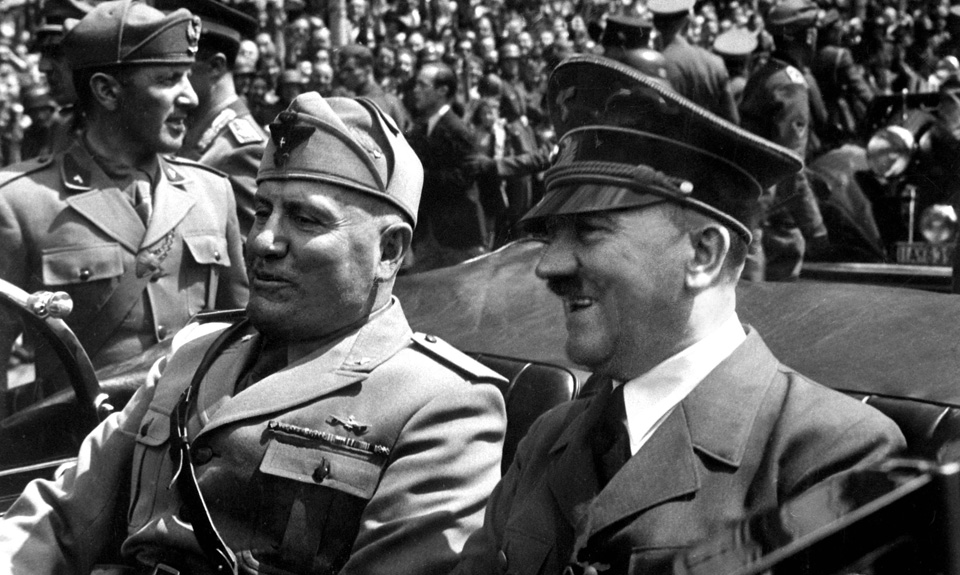
In “It wasn’t just hate – Fascism promised to solve capitalism’s problems,” author Sheri Berman seeks reasons for fascism’s appeal but in so doing offers a whitewashed history of fascism and its rise in both Italy and Germany. She claims Italian fascists and German Nazis started out not “simply by appealing to citizens’ darkest instincts” but by speaking to “the needs of citizens to be protected from the ravages of capitalism at a time when other political actors were offering little help.”
The point of the article seems to be a cautionary tale for today: The current rise to power of Donald Trump in the United States and anti-immigrant parties throughout Europe is a result of the inadequate responses of liberal democratic parties (think the Democrats in the U.S. context) to capitalism’s ravages of unemployment, poverty and crime.
The problem with this analysis is it grossly ignores, glosses over and distorts the use of hate and the methods in which it is implemented, including with violence and repression. As important as ideology is, hate was more than a propaganda tool. Fascists normalized it through the economic, legal, political, educational and other levers of power at their disposal, including state and extra-legal violence, all of which had profound psychological effects as well.
It is hard to imagine fascists offering actual protection from the “ravages of capitalism,” when a pillar of fascist ideology is scapegoating others for causing those ravages. They never blamed a system, per se, but they did blame “markets,” foreigners” and “elites,” all of which, whether coded or overt, do not suggest a system but a conspiracy out to get the upstanding, hardworking and forgotten citizen.
Racialized oppression is a capitalist tool to not only divide people but to extract more wealth from them. Some of the biggest capitalists in the world embraced fascism, including Henry Ford. By detaching hate from its capitalist class origins, it fosters an anti-capitalist image of fascists, when they were not against capitalism. They were its armed enforcers.
If there were parallels between Trump’s Electoral College victory and the rise of fascism in Europe, then they might be found in how both obscured the class nature of capitalism by dividing people along racial lines and convincing enough white voters to identify with a bunch of billionaires, corporate CEOs, generals and white supremacists instead of those who they may share more in common with than skin color or national origin.
Trump blamed the nation’s woes on everything and everybody – but not capitalism (and of course not the GOP either). He blamed the first black president, Barack Obama, and his eight years of (according to Trump) “incompetent” and “corrupt” government (the swamp). He blamed Mexicans and Muslims, immigration and globalization, too. Once in awhile, he’d mention Wall Street and the elites.
Hitler blamed communists, foreigners and Jews for Germany’s woes. Mussolini blamed, as Berman herself wrote, the “pernicious influence of foreigners and markets.” They blamed “elites” too, but that word was (and remains) racially coded. Besides, is blaming “foreigners and markets” or Mexicans and trade deals the same as blaming capitalism?
Mussolini and Italian fascism
Italian fascism enjoyed popular support and did not become “racialized,” until Italian dictator Benito Mussolini joined forces with Adolf Hitler, according to Berman. She called Mussolini’s fascist party “Italy’s first true ‘people’s party’” because they offered Italians “social security, solidarity, and protection from capitalist crises” after World War I, when Italy’s socialist and Catholic political parties failed to do so. Mussolini invested in public works projects that gave Italians jobs. He instilled national unity and identity for a relatively young republic, and the people responded with their support.
However, years before “Mussolini threw his lot in with Hitler,” Italian fascists were not benign and benevolent political actors looking to represent the working class and people’s interests against the capitalist class. No, instead, the once-socialist-turned-fascist Mussolini and his Blackshirts were used to break Italy’s 1920 General Strike and relied on armed force to grab power during their 1922 March on Rome. Italian fascists ruled through fear and violence. The rise of Mussolini was not some stroll into Rome with paternalistic promises of protection, but a paramilitary takeover in which any opposition was exiled and imprisoned.
Michael Ebner, author of Ordinary Violence in Mussolini’s Italy, said official documents and letters “told the stories of ordinary people, families, and communities living under a violent Fascist dictatorship.” Tens of thousands of Italians were arrested and deported to island penitentiaries from 1926 to 1943. Many of them were socialists, trade unionists, homosexuals, and racial and religious minorities. Perhaps one of the most famous prisoners of the fascist regime was Antonio Gramsci, a Marxist theoretician and one of the founders of the Communist Party of Italy.
“Over the course of the dictatorship, institutions of punishment and confinement proliferated. By the time of Italy’s involvement in the Second World War, there were concentration camps, political prisons, work houses, confinement colonies, and sites of internment scattered throughout the entire Italian peninsula,” Ebner wrote.
In addition to the arrests, deportations and imprisonment, the fascists employed other forms of violence. “The summary removal of people from their homes in the middle of the night,” and “the trauma of poverty, which the police state knowingly and sometimes deliberately inflicted on wives and children of detainees.”
Mussolini’s government built a huge patronage system in which jobs, business permits and other aid were used as rewards and punishment depending upon loyalty to the fascist politicians.
Mussolini’s regime did not kill Italians en masse, however, it did commit mass atrocities in Africa in its quest for colonial rule. As many Americans know from our own experience, racism and xenophobia can be instruments of war and occupation. Mussolini used European/white supremacy ideology to foster Italian national unity.
Mussolini said Italian colonialism was an attempt to “bring civilization to backward lands” and offered protection not from capitalism, but from the “numeric and geographic expansion of the yellow and black races,” which if allowed to go unchecked would mean “the civilization of the white man is destined to perish.” For many Italians, national unity was based on an existential “us versus them” white supremacy.
From 1923-32, the Italians conducted a brutal war and occupation in Libya. One-quarter of the indigenous population was wiped out, and 100,000 were forced out of their homes and off their land. Italian colonial rule in Libya was so vicious that in 2008, the right-wing Italian Prime Minister Silvio Berlusconi was forced to apologize to the people of Libya and pay $5 billion in reparations.
Italy also controlled colonies in Eastern Africa, and in 1935 war broke out in neighboring, independent Ethiopia. Italians employed methods in Ethiopia brutally similar to those that had characterized their Libyan campaign, including the use of chemical weapons.
In her book, Fascist Modernities: Italy, 1922-1945, author Ruth Ben-Ghiat wrote, “Between 1935 and 1939, in defiance of the 1925 Geneva Protocol bans on the use of chemical weapons, 617 tons of gas were shipped to Ethiopia. Together with slaughter from conventional weapons, gassings caused a quarter-million Ethiopian deaths by 1938.”
These wars involved tens of thousands of Italian soldiers and influenced the thinking and racial attitudes of the Italian public and Diaspora. According to my own family stories, my Italian-born immigrant grandmother, when provoked, would hurl the insult “go back to Ethiopia.”
Italy’s colonies in Africa provided Mussolini a source of wealth, which could be converted to public works projects at home that projected the image of grandness and strength, as well as a release valve through which the unemployed could be sent as soldiers.
Although Italian fascists modeled their eventual anti-Jewish policies after the German Nazis’,
Italy’s early colonialism and the fascist desire to get rid of so-called undesirables helped to spur later official anti-Semitic campaigns, according to Ben-Ghiat.
Germany and the rise of Hitler
Although Berman blames virulent anti-Semitic German fascism for the decline of Mussolini’s popularity and the downfall of his regime, she glosses over it when it comes to Hitler and the Nazi Party’s rise to power.
Citing the Nazis’ promises to “serve the entire German people,” to fight the Depression and “create a ‘people’s community’ that would overcome the country’s divisions,” Berman said these vows contrasted boldly “with the meekness and austerity of the government and the socialists.”
Berman added with a “but” that the “German fascist vision of ‘the people’ did not include Jews and other ‘undesirables.’”
But just stating that is not enough. It minimizes the impact of state-sanctioned hate on the population.
For example, Berman credits the Nazis with “quickly” implementing job creation programs after Hitler became chancellor in 1933, cutting unemployment significantly. “German unemployment fell from almost 6 million in early 1933 to 2.4 million by the end of 1934,” she wrote, adding the Nazis “exhorted business to take on workers, and doled out credit.”
Not mentioned was the Nazi 1933 boycott of Jewish businesses. According to the U.S. Holocaust Memorial Museum website, “On the day of the boycott, Storm Troopers stood menacingly in front of Jewish-owned shops. The six-pointed ‘Star of David’ was painted in yellow and black across thousands of doors and windows. Signs were posted saying ‘Don’t Buy from Jews’ and ‘The Jews Are Our Misfortune.’”
The significance of omitting Jewish people or others from the phrase “the people” is relevant for today. In responding to an appalling comparison that White House spokesperson Sean Spicer made between Syria’s Bashar al-Assad and Hitler, Yale history professor Timothy Snyder pointed to the danger in minimizing Nazi language that excludes a population from even being considered people.
When Spicer said Assad was worse than Hitler because even he did not use “gas on his own people” not only was that a denial of the Nazi gas chambers; it was also a denial of the humanity of German Jews.
“The key phrase spoken by Spicer was ‘his own people’. …The truth is, Hitler did kill his own people. And the killing began with the disowning,” wrote Snyder in the UK’s Guardian.
“As Victor Klemperer, the great student of Nazi language, long ago pointed out, when Nazis spoke of ‘the people’ they always meant ‘some people’. Spicer has imitated that usage. Some people, our ‘own people’, are more worthy of life than others,” he wrote.
Security for none
In detaching hate from why there was support for fascists, Berman robs readers of important historical lessons to grapple with for today. Fascists offered “protection” and “social security” for some people, while blaming some other people for societal problems. It is textbook demagoguery. In the end, there was no protection from capitalism’s ravages or social security for anyone.
Those who believed the fascists would protect them had been, to paraphrase Malcolm X: bamboozled, led astray, run amok.
With Trump in the White House, and the Republicans in control of all three branches of government, along with a majority of state governments, now is the time to heighten, not downplay, an understanding of how racism, immigrant-bashing, sexism, anti-Semitism and Islamophobia work as ruling-class tools to the detriment of all.










